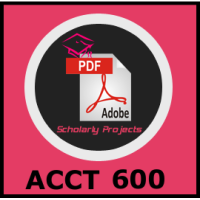ACCT 600 Week 8
Final Due Diligence Report(Different Project)
Table of Contents
1 EXECUTIVE SUMMARY
2 INDUSTRY OVERVIEW
2.1 Industry Snapshot
2.2 Organization and Structure
2.3 Background and Development
2.4 Current Condition
2.4.1 Exhibit 1
2.4.2 Exhibit 2
2.4.3 Key Statistics for 2010: Industry
2.4.4 Exhibit 3
3 INDUSTRY LEADERS
3.1 Competitor 1
3.2 Competitor 2
3.3 Competitor 3
3.4 Competitor 4
3.4.1 Revenue / Income History
3.5 Competitor 5
3.5.1 Revenue / Income History
3.6 Competitor 6
3.6.1 Revenue / Income History
3.6.2 Exhibit 4
3.6.3 Exhibit 5
3.7 Corporate Overview
3.7.1 Table 1 – Revenue and Income (in thousands) 2008 through 2010
3.7.2 Table 2 – EPS 2008 through 2010
3.7.3 Exhibit 6
4 SWOT
4.1 Strengths
4.2 Locations
4.3 Growth
4.4 Cost
4.5 Range of Merchandise
4.6 Weaknesses
4.7 Ability to Gain Market Share
4.8 Profitability is Vulnerable to Cost Increases
4.9 Pressure from Competitors May Reduce Their Sales and Profits
4.10 Opportunities
4.11 Threats
4.12 New Entrants
4.13 Concentration
4.14 Product Differentiation
4.15 Legal Problems
4.16 Substitute Products
5 CORPORATE CULTURE
5.1 Business Strategy
6 ORGANIZATION AND CORPORATE ISSUES
6.1 Employees
7 CAPITAL STRUCTURE
7.1 Assets
7.2 Lease Agreements
7.3 Accounts Receivable
7.4 Inventories
7.5 Depreciation
7.6 Assets Categories
7.7 Cash and Cash Equivalents
7.8 Short Term Investments
7.9 Long-lived assets
7.10 Deferred Tax Asset
7.10.1 Table 3 - Property, Plant and Equipment past Two Years
7.11 Goodwill
7.12 Other Assets
7.13 Expansion Plans
7.14 Liabilities
7.14.1 Table 4 – Contractual Obligations
7.15 Operating Lease Obligations
7.16 Capital Lease Obligations
7.17 Credit Agreement
7.18 Revenue Bond Financing
7.19 Interest on Long-Term Borrowings
7.19.1 Table 5 - Commitments
7.20 Letters of Credit and Surety Bonds
7.21 Freight Contracts
7.22 Technology Assets
7.23 Derivative Financial Instruments
7.23.1 Tables 6 and 7 – Current and Other Liabilities 2009 and 2010
7.24 Other Current Liabilities
7.25 Other Long-Term Liabilities
7.25.1 Table 8 – Other Long-Term Liabilities
7.26 Long-Term Debt
7.26.1 Table 9 – Long-Term Debt
7.27 Deferred Compensation Plan
7.28 Income Taxes
7.28.1 Table 10 – Provision for Income Taxes 2008 through 2010
7.28.2 Table 11 – Deferred Tax Asset
7.28.3 Table 12 – Unrecognized Tax Benefits
7.29 Zero Balance Line of Credit and Risk Hedging
8 PERFORMANCE MEASUREMENTS
8.1 Asset Utilization
8.1.1 Table 13 – Sales to Working Capital 2008 through 2010
8.1.2 Exhibit 7
8.1.3 Exhibit 8
8.1.4 Table 13- Total Shareholder’s Equity 2008 through 2010
8.1.5 Exhibit 9
8.2 Operating Performance
8.2.1 Exhibit 10
8.2.2 Exhibit 11
8.3 Return on Equity (ROE)
8.3.1 Exhibit 12
8.4 Earnings Per Share
8.4.1 Exhibit 13
8.5 Cash Flow
8.5.1 Exhibit 14
8.5.2 Exhibit 15
8.6 Capital Structure and Solvency
8.6.1 Exhibit 16
8.6.2 Exhibit 17
8.6.3 Exhibit 18
8.6.4 Exhibit 19
8.7 Net Profit Margin
8.7.1 Exhibit 20
8.8 Operating Profit Margin
8.8.1 Exhibit 21
8.8.2 Exhibit 22
8.9 Market Performance
8.9.1 P/E Ratio
8.9.2 Exhibit 23
8.10 Capitalization Rate
8.10.1 Exhibit 24
9 FINANCIAL REPORT ANALYSIS
9.1 Consolidated Financial Statements
9.2 Auditing
9.3 Analysis of Financials
9.3.1 Exhibit 25
9.4 Sales
9.5 Third-Quarter Results
9.6 39-Week Period Results
9.7 Financial Update
9.8 GUIDANCE
10 CONCLUSION AND RECOMMENDATION
10.1 Similar Acquisitions
10.2 Combined Value
10.3 Anticipated Financial Performance
11 WORKS CITED
12 APPENDIX
12.1 Financial Report
12.2 Compensation of Executive Officers
12.2.1 Table 14 - Compensation to Executive Officers
12.3 Director Compensation
12.3.1 Table xx – Director Compensation
12.3.2 Table xx
12.4 Compensation Committee
12.5 Incentive Bonuses
12.5.1 Table xx
12.6 Overall Payroll
12.7 Benefit Package
12.8 Biographies of the Consultants {the team}
12.9 The following names list {company} directors’ nominees:
12.10 Committees of the Board of Directors
12.11 Footnotes from the most recent Annual Report
12.11.1 Note x:
